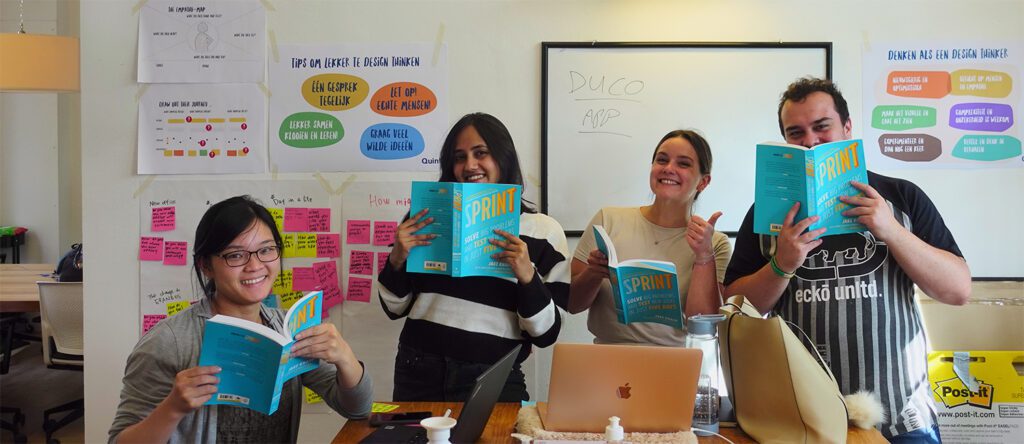Since digital strategy, IoT and even blockchain have become a crucial part of office vocabulary in recent years, an increasing number of organizations are focusing on innovation. But how can they achieve it? How can you embrace an outside-in perspective and connect this to you organizations expertise? And how can you create a culture that nurtures it? This is the key challenge of today. But far too many businesses waste valuable time discussing innovation strategies over actually implementing it.
About Eraneos’ Digital Accelerator Program
Eraneos’ Digital Accelerator Program is one sure-fire way of addressing these challenges, and involving a concrete and user-tested prototype alongside valuable guidelines on how to scale in the space of just 12 weeks. It’s this pressure cooker-style program – combined with design thinking and agile development – that can foster the growth of a bold and innovative solution. The main goal? To stop talking about how future could be, and start shaping it.
Our Digital Accelerator Program is centered around a design thinking approach, which uses elements from the designer’s toolkit, like empathy research and experimentation, to arrive at innovative solutions. This human-centric, solution-based approach to innovation involves five main stages of (1) empathize, (2) define, (3) ideate, (4) prototype and (5) test. And it’s this methodology that allows us to come up with solutions that are desirable, feasible from a technological perspective, and viable in business terms.
The result: a radical approach to solving strategic problems and discovering value propositions in a swift and super-efficient 12-week period.

The challenge
To test and prove this concept, we decided to apply the program for one of our own strategic challenges – designing and building the new Eraneos office in Amsterdam.
Still, it was approached in the same way; a 12-week project that involved hiring a multidisciplinary team of student interns from around the world with diverse backgrounds in technology, business, software and innovation. Supported by Eraneos mentors Pierre de Wit and Peet Sneekes, a team of talents/future Eraneos employees was recruited to help design and develop Eraneos’ new offices in Amsterdam following the merger of Quint group and Anchormen. But why employ students? The idea was that they would provide much-needed fresh perspectives and novel ideas that existing company employees might have missed.
The key challenge for this project revolved around answering the question: “what can an office be for the people working at Eraneos?”. This was far beyond the number of seats and desks there would be – that would be a task for the interior design team. The focus for the students was more related to why people come to the office”, what brings them to the physical workspace as opposed to working from home?
“We were often told that we are not just designing a random office. We were designing an experience that needed to match the spirit of the new brand. It had to be Eraneos-specific.”
The approach
The team of 4 talents were hired after a series of interviews to find the right fit for the project. They were: Alessandro from South Afrika, Akari from Japan, Parineeta from India and Patricia from the US.
“I think we were hired because we come from different nationalities, different countries, different studies,” says Akari. “…design sprints require a lot of creativity, so the diversity part is pretty important.”
After an onboarding about Eraneos’ culture and what it represents, they were thrown into the deep end. The first meeting took place inside the new office – before it was ready, and before the students knew that the project they would be working on would be to redesign that very space. Their schedules were put together immediately, and the following week they took part in daily back-to-back interviews getting to know the people of Eraneos better and the goals of the project.
The first task for the students was to create a questionnaire to survey everyone in the company regarding what they might want from a new office space to ensure it met the requirements of the majority of employees. It featured basic questions like “why would you go to the office?” and “what would keep you away?” to more specific ones, such as “have you been to any cool offices recently that you liked?” and “what do you think the DNA of Eraneos is like?”. The team received more than a hundred responses, which served as a great starting point, and at the end of the week, they presented the findings to Eraneos executives.
The students then built main themes from the intensive research results from the survey and interviews. Since the company was going through a major merger, it was important that they focused on how employees would stay connected with the new name and brand.
“This might seem like something unrelated to the office, but it’s very intertwined,” explains Akari. “We looked at everything around the current office that might fit the new space. So, those were the themes we identified.”
Empathy maps were also completed, to garner how the employees were feeling about different aspects of their jobs. “Because the interviews were really long and it was therefore hard to analyze the data, this was a way to consolidate it into a template for each person,” adds Alessandro. “In the end, we had 17 or 18 empathy maps.”
With around eight themes generated in total, the reference group chose three that they deemed the most important for Eraneos. The next phase was ideation. With the guidance of Pierre and Peet, the students stuck hundreds of sticky notes to a wall with suggestions for the new office space, all of which expanded on the developed themes.
“We needed to find out what each department did, so we created a list of activities for each to analyze what spaces were needed and how people were collaborating in them,” says Akari. “And so we conducted ‘look and feel’ surveys, which were done in collaboration with Refitters – the interior designers who would make the first versions of the floorplan. These surveys would determine if a space should be “homey but professional”, for example.”
After presenting the survey results to Refitters, the students visited four existing offices belonging to the successful corporations Microsoft, Spaces Schiphol, B Amsterdam, and Cognizant Studio. This was to insight inspiration for what to include and what not to include in Eraneos’ space.
“While Refitters worked on the first version of the floorplan using the look and feel activity maps, we were looking into what brings an office to the next level. What brings the office that WOW factor?,” says Akari. “That was the ideation process.”
The next step was for the students to analyze the ideations, filtering out what was not feasible and keeping what was interesting. They consolidated all the ideas into five concepts before presenting them to the board and receiving feedback. From there, they created prototypes and tested them out with employees.
“This was the whole loop of the design thinking,” Akari adds. “Testing it with the employees over and over to see what works and what doesn’t. It was very successful.”

The result
The final floorplan for Eraneos’ new office space was announced at the company’s end-of-the-year party, combining all the students’ concepts to demonstrate more clearly what they were envisioning.
“By combining it with the Refitters’ plan, we were able to show what was part of the process, and they were really happy with the results,” recalls Alessandro. “When asked the reference group: ‘out of the concepts, which do you think should be implemented?’ they replied: a little bit of everything.”
The students believe that the project really played on each of their strengths.
“This is why I think Pierre got a team of diverse people. We all have different strengths and weaknesses. And so we could divide the tasks accordingly between who’s good at doing certain things,” reflects Akari.
For Parineeta, the biggest learning from the Digital Accelerator process was the importance of teamwork. “I’ve never done this kind of work before, it was all very new for me. It was a really good opportunity to get to know such a nice team and work for a project that brings actual value.”
The project certainly proved a success for everyone involved. With Parineeta and Akari in agreement, Alessandro explains how it far exceeded his expectations. “The fact that what we did is going to become something tangible is amazing to me,” he says. “Something that we worked on for three months, where we tried our best, and our results were taken into consideration. An end result in close collaboration with the full Eraneos organization and Refitters, we know we did a good job ”

Let’s create sustainable change together

Contact our experts

